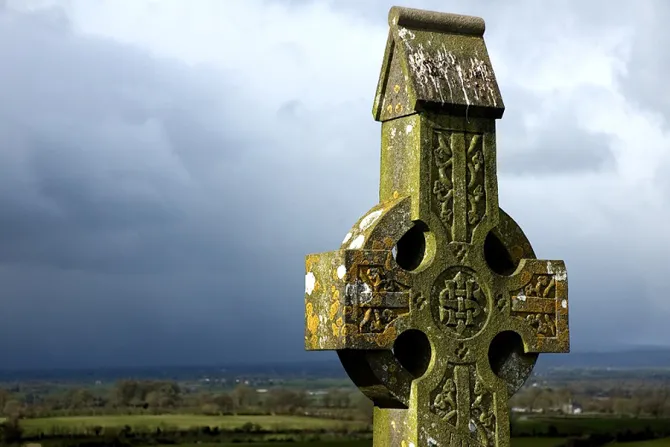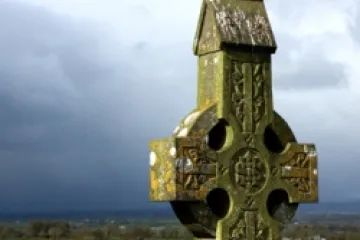CNA Staff, Jan 16, 2021 / 16:28 pm
Catholic bishops have welcomed an Irish government report on 20th century homes for unmarried mothers and babies run by local governments and often operated by religious orders. They have apologized for the harsh treatment of unmarried mothers and their children, calling this a betrayal of Christ.
"Although it may be distressing, it is important that all of us spend time in the coming days reflecting on this report which touches on the personal story and experience of many families in Ireland," Archbishop Eamon Martin of Armagh said Jan. 12.
"The commission's report helps to further open to the light what was for many years a hidden part of our shared history and it exposes the culture of isolation, secrecy and social ostracizing which faced 'unmarried mothers' and their children in this country."
He urged continued outreach to those whose personal testimony was central to the report.
"We owe it to them to take time to study and reflect on the findings and recommendations of the Report, and commit to doing what we can to help and support them," he said. "We must identify, accept and respond to the broader issues which the report raises about our past, present and future."
The Irish Commission of Investigation into Mother and Baby Homes released its report Jan. 12. The six-year inquiry concerned 14 "mother and baby" homes and four "county homes" in the time period of 1922 to 1998. The report examines individual homes and individual witness testimonies as well as providing historical context for the actions of the women, their babies' fathers, their families, government officials, and religious leaders involved.
"Women who gave birth outside of marriage were subject to particularly harsh treatment. Responsibility for that harsh treatment rests mainly with the fathers of their children and their own immediate families," said the report. "It was supported by, contributed to, and condoned by, the institutions of the State and the Churches."
"However, it must be acknowledged that the institutions under investigation provided a refuge – a harsh refuge in some cases – when the families provided no refuge at all," it added.
About 56,000 women and girls, as young as 12 or in their forties, were sent to these institutions. The county homes were government-run and -operated, while the mother and baby homes were generally run with government support by Catholic religious religious orders, technically under the authority of their local bishop.
About 57,000 babies were born in the homes over this 76-year period. There was a significant mortality rate, with 15 percent of babies dying before they left the homes. The high mortality rate was known to authorities and recorded, but there was no outcry and little effort to address these problems. The commission report said the high infant mortality rate was the institutions' most "disquieting feature." Before 1960, the institutions appeared to have "significantly reduced" survival prospects.
Some county homes had "appalling physical conditions," as did the homes at Tuam, in County Galway, and Kilrush, in County Clare. Other homes were "considerably better."
While poor living conditions were common in Ireland, poor sanitary conditions in the group homes had "much more serious consequences." There was oversight and inspection reports were critical of conditions, but maximum capacity figures were not set for mother and baby homes until the 1940s. These figures were not enforced, because they would have massively reduced the homes' capacity.
Archbishop Martin welcomed the report, saying, "as a Church leader today, I accept that the Church was clearly part of that culture in which people were frequently stigmatized, judged and rejected." He "unreservedly apologized" to the survivors and all impacted for the enduring hurt and emotional distress.
"As Church, State and wider society we must ensure together that, in the Ireland of today, all children and their mothers feel wanted, welcomed and loved," Archbishop Martin said. We must also continue to ask ourselves where people today might feel similarly rejected, abandoned, forgotten or pushed to the margins."
"Mindful of the Gospel of Jesus Christ, which calls us to protect life and dignity and to treat everyone - especially little children and all who are vulnerable - with love, compassion and mercy, I believe the Church must continue to acknowledge before the Lord and before others its part in sustaining what the Report describes as a 'harsh … cold and uncaring atmosphere'," Martin said.
While some 200 women who gave birth died while living at mother and baby homes, the report indicated that they likely received better maternal care than most Irish women through the 1960s or 1970s, as most gave birth at home with the aid of a midwife or even an untrained aid. Many Irish homes lacked running water. At the same time, county hospitals discriminated against unmarried women and would not admit them to maternity wards until the 1960s.
The report attributed the end of the homes to massive improvements in living conditions, changes in religious and moral attitudes, as well as gradual improvements like free post-primary education, the establishment of legal adoption in 1953, and an allowance for unmarried mothers in 1973.
(Story continues below)
Providing historical context, the report said that such homes were not particular to Ireland, at the same time the proportion of unmarried mothers admitted to these homes in the 20th century was "probably the highest in the world." The group home system was believed to reduce the women's risk of entering prostitution or committing infanticide. The system also purported to advance their moral reform.
"Some pregnancies were the result of rape; some women had mental health problems, some had an intellectual disability. However, the majority were indistinguishable from most Irish women of their time," said the report.
In the first decades of the time period concerned, most women admitted to the institutions were domestic servants, farm workers, or unpaid domestic workers in their family homes. In later decades, women were clerical workers, civil servants, professionals, and schoolgirls or post-secondary students.
Many of these pregnant women had failed to secure support from their families or the fathers of the babies and were destitute. Some women entered the homes to prevent family and neighbors from learning they were pregnant. Some were forcibly brought to the homes by family members. There was no evidence that pregnancies among under-age women were routinely reported to police. There is no evidence Church or state officials forced them to enter, but most women "had no alternative," the report said.
Most were financially supported in the institutions by the local government health authority. Many women were cut off from the world and assigned a "house name."
Both Irish men and women were more likely to be dependent on their parents into their early twenties. Families tended to have many children and would be less able to support an unmarried daughter's baby. An out-of-wedlock birth could destroy marriage prospects for both the woman and her siblings.
Irish men were also reluctant to marry, especially to marry young. The commission said it is possible that fewer men married their pregnant girlfriend than they did in other countries. Land inheritance customs and economic necessity meant land passed only to one son.
It was often impossible for pregnant women to prove paternity claims, and compared to other countries a low proportion of Irish men acknowledged paternity or provided financial support. Before 1950, many fathers were themselves financially imperiled, working low-wage jobs or unpaid jobs for family farms and businesses.
Most children born in the institutions were too young to remember, but some stayed after their mothers left through age seven. Legal adoption, which the report called a "vastly better outcome," was not available until 1953, with farming communities still proving less likely to adopt. Children often ended up in industrial schools or were boarded out.
While the Catholic hierarchy evidently had no role in the day-to-day operation of mother and baby homes, religious congregations who opened such homes required the local bishop's permission. Local authorities often deferred to the views of these religious orders or to the views of the local bishop.
"The Catholic church did not invent Irish attitudes to prudent marriages or family respectability; however, it reinforced them through church teachings that emphasized the importance of pre-marital purity and the sexual dangers associated with dance halls, immodest dress, mixed bathing and other sources of 'temptation'," said the report.
There is no evidence the religious orders running these homes made a profit, said the report, which added: "At various times, it is clear that they struggled to make ends meet."
The report suggested that the mortality rate was higher than the Irish norm either because of the high risk of infection, or because the children born in mother and baby homes came from less privileged backgrounds than other women who gave birth out-of-wedlock but had healthier pregnancies and healthier babies. Women who gave birth in the homes had more stressful lives and worse pre-natal care and nutrition. There was a failure to implement appropriate hygiene standards at the homes and to educate mothers about hygiene. Almost all the homes lacked the staff needed to perform such education.
Infant mortality rates at the homes peaked in the 1940s, a time of economic difficulty due in significant part to the Second World War.
Archbishop Dermot Farrell of Dublin welcomed the report's publication, saying such reports "bring to light the profound injustices perpetrated against the vulnerable in our society over a long period of time – against women and children whose lives were regarded as less important than the lives of others."
"The silence which surrounded this shameful time in the history of our land had long needed to be shattered," he said. "The pain of those who were hidden away must be heard; those once largely without a voice now can speak clearly to our world, and we need to listen, even when what we hear pierces to the heart."
"A genuine response is required: ours – as a Church and a society – can only be a full apology, without any reservation. There should never have been a time for avoidance and facile solutions," he said. "This country, the Church, our communities and families are better places when the light of truth and healing are welcomed. May the Lord's compassion be the touchstone of our response. May the light of Christ bring healing to all."
Bishop Tom Deenihan of Meath also apologized, saying: "While a lack of resources and an intense social poverty go some way towards contextualizing the period of this report, the lack of kindness and compassion, as identified by the commission, is also clear."
Residents and children born in these institutions suffered from "unacceptable conditions" and inadequate assistance, and they have been "unfairly burdened with an unwarranted but enduring sense of shame," he said.
The long-closed Tuam Children's Home in County Galway became notorious after the discovery of an unmarked mass grave for children. Some 2,219 women and 3,251 children had been at the home, and 978 children died-80 percent before their first birthday.
The home was operated by the Bon Secours Sisters in from 1925 to 1961. In addition to unmarried mothers and their babies, it also accepted children of destitute and homeless families as well as children with special needs.
It is likely that many children who died are buried in the memorial gardens, but while there are records of their deaths there is no record of their burial places.
The Bon Secours sisters offered "profound apologies." They said that the children who died at the home were buried in a "disrespectful and unacceptable way," the Irish Times reports.
Sister Eileen O'Connor, the local superior of the Bon Secour Sisters, said Jan. 12 that the report "presents a history of our country in which many women and children were rejected, silenced and excluded; in which they were subjected to hardship; and in which their inherent human dignity was disrespected, in life and in death. Our Sisters of Bon Secours were part of this sorrowful history."
"We failed to respect the inherent dignity of the women and children who came to the home. We failed to offer them the compassion that they so badly needed. We were part of the system in which they suffered hardship, loneliness and terrible hurt," O'Connor said. "We acknowledge in particular that infants and children who died at the home were buried in a disrespectful and unacceptable way. For all that, we are deeply sorry."
Archbishop Michael Neary of Tuam also welcomed the report and asked forgiveness for "the abject failure of the Church for the pain and suffering visited on those women and their children."
"The Church of Jesus Christ was intended to bring hope and healing, yet it brought harm and hurt for many of these women and children," he said. "Many were left broken, betrayed and disillusioned. For them, and all of us, these revelations seriously tarnished the image of the Church."
The Galway County Council owned the Tuam home and was responsible for the residents, and the sisters operated it. The diocese had no administrative role. However, Neary emphasized, the diocese had a pastoral role, "in that the priests of Tuam parish served as chaplains."
"Today, how can we even begin to comprehend the raw pain and psychological damage of family separation and its devastating consequences on loving mothers and on the emotional development of their children?" he asked. "Must we ask as to the whereabouts of the fathers? Had the Church been more forthright in acknowledging the responsibility of the men who fathered these children, the outcome for many young mothers and their children would have been very different indeed."
The diocesan archives on the home have been shared with the commission, but the archive does not have information on the living conditions. Neary lamented the absence of burial location records, saying the burials have "understandably, caused the most outrage." He welcomed any progress in uncovering the full truth.
Dublin's Regina Coeli hostel, founded by the Legion of Mary, appeared to show some ability to break with the trends of Irish society. The full report's 21st chapter says that the hostel was "the only institution that assisted unmarried mothers to keep their infant" before the 1970s, the Iona Institute reports.
"Although the mothers who kept their babies were a minority until the 1970s, the proportion was undoubtedly much higher than for any other institution catering for unmarried mothers"
Venerable Frank Duff, the layman founder of the Legion of Mary, wrote a 1950 memorandum to the Department of Health about encouraging women to keep their children. Duff opposed committing children to Ireland's industrial schools, which have also been the target of historical inquiry for poor conditions and abuse of their residents.
The hostel received no regular state support. At the same time, babies of women at the hostel suffered a high mortality rate, which peaked in the 1940s, and other reports have questioned the conditions there.




